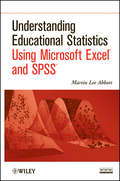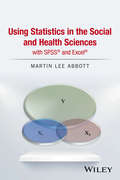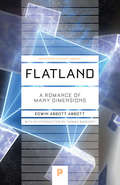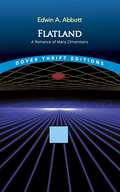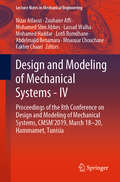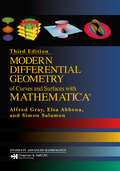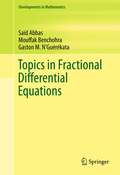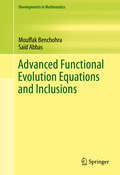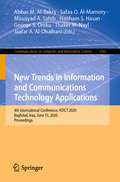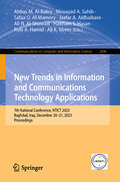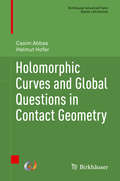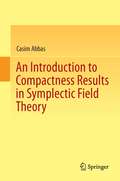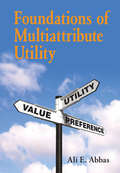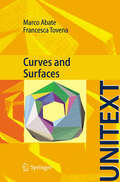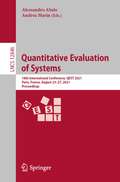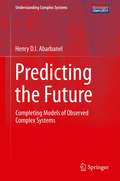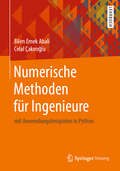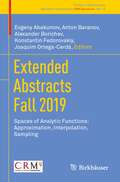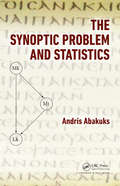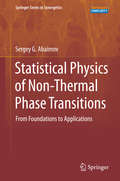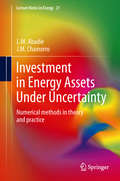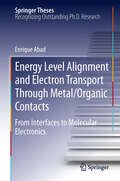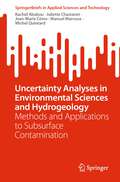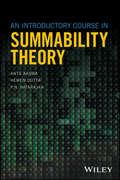- Table View
- List View
Understanding Educational Statistics Using Microsoft Excel® and Spss®
by Martin Lee AbbottUtilizing the latest software, this book presents the essential statistical procedures for drawing valuable results from data in the social sciences. Mobilizing interesting real-world examples from the field of education, Understanding Educational Statistics Using Microsoft Excel and SPSS supplies a seamless presentation that identifies valuable connections between statistical applications and research design. Class-tested to ensure an accessible presentation, the book combines clear, step-by-step explanations and the use of software packages that are accessible to both the novice and professional alike to present the fundamental statistical practices for organizing, understanding, and drawing conclusions from educational research data. The book begines with an introduction to descriptive and inferential statistics and then proceeds to acquaint readers with the various functions for working with quantitative data in the Microsoft Excel environment, such as spreadsheet navigation; sorting and filtering; and creating pivot tables. Subsequent chapters treat the procedures that are commonly-employed when working with data across various fields of social science research, including: Single-sample tests Repeated measure tests Independent t-tests One way ANOVA and factorial ANOVA Correlation Bivariate regression Chi square Multiple regression Individual chapters are devoted to specific procedures, each ending with a lab exercise that highlights the importance of that procedure by posing a research question, examining the question through its application in Excel and SPSS, and concluding with a brief research report that outlines key findings drawn from the results. Real-world examples and data from modern educational research are used throughout the book, and a related Web site features additional data sets, examples, and labs, allowing readers to reinforce their comprehension of the material. Bridging traditional statistical topics with the latest software and applications in the field of education, Understanding Educational Statistics Using Microsoft Excel and SPSS is an excellent book for courses on educational research methods and introductory statistics in the social sciences at the upper-undergraduate and graduate levels. It also serves as a valuable resource for researchers and practitioners in the fields of education, psychology, and the social sciences who require a statistical background to work with data in their everyday work.
Using Statistics in the Social and Health Sciences with SPSS and Excel
by Martin Lee AbbottProvides a step-by-step approach to statistical procedures to analyze data and conduct research, with detailed sections in each chapter explaining SPSS® and Excel® applications This book identifies connections between statistical applications and research design using cases, examples, and discussion of specific topics from the social and health sciences. Researched and class-tested to ensure an accessible presentation, the book combines clear, step-by-step explanations for both the novice and professional alike to understand the fundamental statistical practices for organizing, analyzing, and drawing conclusions from research data in their field. The book begins with an introduction to descriptive and inferential statistics and then acquaints readers with important features of statistical applications (SPSS and Excel) that support statistical analysis and decision making. Subsequent chapters treat the procedures commonly employed when working with data across various fields of social science research. Individual chapters are devoted to specific statistical procedures, each ending with lab application exercises that pose research questions, examine the questions through their application in SPSS and Excel, and conclude with a brief research report that outlines key findings drawn from the results. Real-world examples and data from social and health sciences research are used throughout the book, allowing readers to reinforce their comprehension of the material. Using Statistics in the Social and Health Sciences with SPSS® and Excel® includes: * Use of straightforward procedures and examples that help students focus on understanding of analysis and interpretation of findings * Inclusion of a data lab section in each chapter that provides relevant, clear examples * Introduction to advanced statistical procedures in chapter sections (e.g., regression diagnostics) and separate chapters (e.g., multiple linear regression) for greater relevance to real-world research needs Emphasizing applied statistical analyses, this book can serve as the primary text in undergraduate and graduate university courses within departments of sociology, psychology, urban studies, health sciences, and public health, as well as other related departments. It will also be useful to statistics practitioners through extended sections using SPSS® and Excel® for analyzing data. Martin Lee Abbott, PhD, is Professor of Sociology at Seattle Pacific University, where he has served as Executive Director of the Washington School Research Center, an independent research and data analysis center funded by the Bill & Melinda Gates Foundation. Dr. Abbott has held positions in both academia and industry, focusing his consulting and teaching in the areas of statistical procedures, program evaluation, applied sociology, and research methods. He is the author of Understanding Educational Statistics Using Microsoft Excel® and SPSS®, The Program Evaluation Prism: Using Statistical Methods to Discover Patterns, and Understanding and Applying Research Design, also from Wiley.
Flatland: A Romance of Many Dimensions
by Edwin Abbott Abbott Thomas BanchoffIn 1884, Edwin Abbott Abbott wrote a mathematical adventure set in a two-dimensional plane world, populated by a hierarchical society of regular geometrical figures-who think and speak and have all too human emotions. Since then Flatland has fascinated generations of readers, becoming a perennial science-fiction favorite. By imagining the contact of beings from different dimensions, the author fully exploited the power of the analogy between the limitations of humans and those of his two-dimensional characters. A first-rate fictional guide to the concept of multiple dimensions of space, the book will also appeal to those who are interested in computer graphics. This field, which literally makes higher dimensions seeable, has aroused a new interest in visualization. We can now manipulate objects in four dimensions and observe their three-dimensional slices tumbling on the computer screen. But how do we interpret these images? In his introduction, Thomas Banchoff points out that there is no better way to begin exploring the problem of understanding higher-dimensional slicing phenomena than reading this classic novel of the Victorian era.
Flatland: A Romance of Many Dimensions (Dover Thrift Editions: Classic Novels)
by Edwin A. AbbottThis masterpiece of science (and mathematical) fiction is a delightfully unique and highly entertaining satire that has charmed readers for more than 100 years. The work of English clergyman, educator and Shakespearean scholar Edwin A. Abbott (1838-1926), it describes the journeys of A. Square, a mathematician and resident of the two-dimensional Flatland, where women-thin, straight lines-are the lowliest of shapes, and where men may have any number of sides, depending on their social status.Through strange occurrences that bring him into contact with a host of geometric forms, Square has adventures in Spaceland (three dimensions), Lineland (one dimension) and Pointland (no dimensions) and ultimately entertains thoughts of visiting a land of four dimensions—a revolutionary idea for which he is returned to his two-dimensional world. Charmingly illustrated by the author, Flatland is not only fascinating reading, it is still a first-rate fictional introduction to the concept of the multiple dimensions of space. "Instructive, entertaining, and stimulating to the imagination." — Mathematics Teacher.
Design and Modeling of Mechanical Systems - IV: Proceedings of the 8th Conference on Design and Modeling of Mechanical Systems, CMSM'2019, March 18–20, Hammamet, Tunisia (Lecture Notes in Mechanical Engineering)
by Mohamed Slim Abbes Fakher Chaari Mohamed Haddar Lotfi Romdhane Abdelmajid Benamara Mnaouar Chouchane Nizar Aifaoui Zouhaier Affi Lassad WalhaThis book offers a collection of original peer-reviewed contributions presented at the 8th International Congress on Design and Modeling of Mechanical Systems (CMSM’2019), held in Hammamet, Tunisia, from the 18th to the 20th of March 2019. It reports on research, innovative industrial applications and case studies concerning mechanical systems and related to modeling and analysis of materials and structures, multiphysics methods, nonlinear dynamics, fluid structure interaction and vibroacoustics, design and manufacturing engineering. Continuing on the tradition of the previous editions, these proceedings offers a broad overview of the state-of-the art in the field and a useful resource for academic and industry specialists active in the field of design and modeling of mechanical systems. CMSM’2019 was jointly organized by two leading Tunisian research laboratories: the Mechanical Engineering Laboratory of the National Engineering School of Monastir, University of Monastir and the Mechanical, Modeling and Manufacturing Laboratory of the National Engineering School of Sfax, University of Sfax.
Modern Differential Geometry of Curves and Surfaces with Mathematica (Textbooks in Mathematics)
by Elsa Abbena Simon Salamon Alfred Gray<p>Presenting theory while using Mathematica in a complementary way, Modern Differential Geometry of Curves and Surfaces with Mathematica, the third edition of Alfred Gray’s famous textbook, covers how to define and compute standard geometric functions using Mathematica for constructing new curves and surfaces from existing ones. Since Gray’s death, authors Abbena and Salamon have stepped in to bring the book up to date. While maintaining Gray's intuitive approach, they reorganized the material to provide a clearer division between the text and the Mathematica code and added a Mathematica notebook as an appendix to each chapter. They also address important new topics, such as quaternions. <p>The approach of this book is at times more computational than is usual for a book on the subject. For example, Brioshi’s formula for the Gaussian curvature in terms of the first fundamental form can be too complicated for use in hand calculations, but Mathematica handles it easily, either through computations or through graphing curvature. Another part of Mathematica that can be used effectively in differential geometry is its special function library, where nonstandard spaces of constant curvature can be defined in terms of elliptic functions and then plotted. Using the techniques described in this book, readers will understand concepts geometrically, plotting curves and surfaces on a monitor and then printing them. <p>Containing more than 300 illustrations, the book demonstrates how to use Mathematica to plot many interesting curves and surfaces. Including as many topics of the classical differential geometry and surfaces as possible, it highlights important theorems with many examples. It includes 300 miniprograms for computing and plotting various geometric objects, alleviating the drudgery of computing things such as the curvature and torsion of a curve in space.</p>
Topics in Fractional Differential Equations
by Saïd Abbas Mouffak Benchohra Gaston M. N'GuérékataTopics in Fractional Differential Equations is devoted to the existence and uniqueness of solutions for various classes of Darboux problems for hyperbolic differential equations or inclusions involving the Caputo fractional derivative. Fractional calculus generalizes the integrals and derivatives to non-integer orders. During the last decade, fractional calculus was found to play a fundamental role in the modeling of a considerable number of phenomena; in particular the modeling of memory-dependent and complex media such as porous media. It has emerged as an important tool for the study of dynamical systems where classical methods reveal strong limitations. Some equations present delays which may be finite, infinite, or state-dependent. Others are subject to an impulsive effect. The above problems are studied using the fixed point approach, the method of upper and lower solution, and the Kuratowski measure of noncompactness. This book is addressed to a wide audience of specialists such as mathematicians, engineers, biologists, and physicists.
Advanced Functional Evolution Equations and Inclusions (Developments in Mathematics #39)
by Saïd Abbas Mouffak BenchohraThis book presents up-to-date results on abstract evolution equations and differential inclusions in infinite dimensional spaces. It covers equations with time delay and with impulses, and complements the existing literature in functional differential equations and inclusions. The exposition is devoted to both local and global mild solutions for some classes of functional differential evolution equations and inclusions, and other densely and non-densely defined functional differential equations and inclusions in separable Banach spaces or in Fréchet spaces. The tools used include classical fixed points theorems and the measure-of non-compactness, and each chapter concludes with a section devoted to notes and bibliographical remarks. This monograph is particularly useful for researchers and graduate students studying pure and applied mathematics, engineering, biology and all other applied sciences.
New Trends in Information and Communications Technology Applications: 4th International Conference, NTICT 2020, Baghdad, Iraq, June 15, 2020, Proceedings (Communications in Computer and Information Science #1183)
by Abbas M. Al-Bakry Safaa O. Al-Mamory Mouayad A. Sahib Haitham S. Hasan George S. Oreku Thaker M. Nayl Jaafar A. Al-DhaibaniThis book constitutes refereed proceedings of the 4th International Conference on New Trends in Information and Communications Technology Applications, NTICT 2020, held on June 15, 2020. The NTICT conference was planned to take place in Baghdad on March 11-12, 2019, but due to the COVID-19 pandemic the conference has been postponed on June 15, 2020 and moved to the virtual format.The 15 full papers and 3 short papers presented were thoroughly reviewed and selected from 90 qualified submissions. The volume presents the latest research results in such areas as network protocols, overlay and other logical network structures, wireless access networks, computer vision, machine learning, artificial Intelligence, data mining, control methods.
New Trends in Information and Communications Technology Applications: 7th National Conference, NTICT 2023, Baghdad, Iraq, December 20–21, 2023, Proceedings (Communications in Computer and Information Science #2096)
by Abbas M. Al-Bakry Safaa O. Al-Mamory Mouayad A. Sahib Haitham S. Hasan Jaafar A. Aldhaibani Ali N. Al-Shuwaili Rula A. Hamid Ali K. IdreesThis book constitutes the refereed proceedings of the 7th National Conference on New Trends in Information and Communications Technology Applications, NTICT 2023, held in Baghdad, Iraq, during December 20–21, 2023. The 28 full papers included in this book were carefully reviewed and selected from 92 submissions. They were organized in topical sections as follows: artificial intelligence and machine learning; and computer networks.
Holomorphic Curves and Global Questions in Contact Geometry (Birkhäuser Advanced Texts Basler Lehrbücher)
by Casim Abbas Helmut HoferThis book explains the foundations of holomorphic curve theory in contact geometry. By using a particular geometric problem as a starting point the authors guide the reader into the subject. As such it ideally serves as preparation and as entry point for a deeper study of the analysis underlying symplectic field theory.An introductory chapter sets the stage explaining some of the basic notions of contact geometry and the role of holomorphic curves in the field. The authors proceed to the heart of the material providing a detailed exposition about finite energy planes and periodic orbits (chapter 4) to disk filling methods and applications (chapter 9).The material is self-contained. It includes a number of technical appendices giving the geometric analysis foundations for the main results, so that one may easily follow the discussion. Graduate students as well as researchers who want to learn the basics of this fast developing theory will highly appreciate this accessible approach taken by the authors.
An Introduction to Compactness Results in Symplectic Field Theory
by Casim AbbasThis book provides an introduction to symplectic field theory, a new and important subject which is currently being developed. The starting point of this theory are compactness results for holomorphic curves established in the last decade. The author presents a systematic introduction providing a lot of background material, much of which is scattered throughout the literature. Since the content grew out of lectures given by the author, the main aim is to provide an entry point into symplectic field theory for non-specialists and for graduate students. Extensions of certain compactness results, which are believed to be true by the specialists but have not yet been published in the literature in detail, top off the scope of this monograph.
Foundations of Multiattribute Utility
by Ali E. AbbasMany of the complex problems faced by decision makers involve uncertainty as well as multiple conflicting objectives. This book provides a complete understanding of the types of objective functions that should be used in multiattribute decision making. By using tools such as preference, value, and utility functions, readers will learn state-of-the-art methods to analyze prospects to guide decision making and will develop a process that guarantees a defensible analysis to rationalize choices. Summarizing and distilling classical techniques and providing extensive coverage of recent advances in the field, the author offers practical guidance on how to make good decisions in the face of uncertainty. This text will appeal to graduate students and practitioners alike in systems engineering, operations research, business, management, government, climate change, energy, and healthcare.
Curves and Surfaces (UNITEXT)
by M. Abate F. TovenaThe book provides an introduction to Differential Geometry of Curves and Surfaces. The theory of curves starts with a discussion of possible definitions of the concept of curve, proving in particular the classification of 1-dimensional manifolds. We then present the classical local theory of parametrized plane and space curves (curves in n-dimensional space are discussed in the complementary material): curvature, torsion, Frenet's formulas and the fundamental theorem of the local theory of curves. Then, after a self-contained presentation of degree theory for continuous self-maps of the circumference, we study the global theory of plane curves, introducing winding and rotation numbers, and proving the Jordan curve theorem for curves of class C2, and Hopf theorem on the rotation number of closed simple curves. The local theory of surfaces begins with a comparison of the concept of parametrized (i.e., immersed) surface with the concept of regular (i.e., embedded) surface. We then develop the basic differential geometry of surfaces in R3: definitions, examples, differentiable maps and functions, tangent vectors (presented both as vectors tangent to curves in the surface and as derivations on germs of differentiable functions; we shall consistently use both approaches in the whole book) and orientation. Next we study the several notions of curvature on a surface, stressing both the geometrical meaning of the objects introduced and the algebraic/analytical methods needed to study them via the Gauss map, up to the proof of Gauss' Teorema Egregium. Then we introduce vector fields on a surface (flow, first integrals, integral curves) and geodesics (definition, basic properties, geodesic curvature, and, in the complementary material, a full proof of minimizing properties of geodesics and of the Hopf-Rinow theorem for surfaces). Then we shall present a proof of the celebrated Gauss-Bonnet theorem, both in its local and in its global form, using basic properties (fully proved in the complementary material) of triangulations of surfaces. As an application, we shall prove the Poincaré-Hopf theorem on zeroes of vector fields. Finally, the last chapter will be devoted to several important results on the global theory of surfaces, like for instance the characterization of surfaces with constant Gaussian curvature, and the orientability of compact surfaces in R3.
Quantitative Evaluation of Systems: 18th International Conference, QEST 2021, Paris, France, August 23–27, 2021, Proceedings (Lecture Notes in Computer Science #12846)
by Alessandro Abate Andrea MarinThis book constitutes the proceedings of the 18th International Conference on Quantitative Evaluation Systems, QEST 2021, held in Paris, France, in August 2021.The 21 full papers and 2 short papers presented together with 2 keynote papers were carefully reviewed and selected from 47 submissions. The papers are organized in the following topics: probabilistic model checking; quantitative models and metamodels: analysis and validation; queueing systems; learning and verification; simulation; performance evaluation; abstractions and aggregations; and stochastic models.
Predicting the Future
by Henry AbarbanelThrough the development of an exact path integral for use in transferring information from observations to a model of the observed system, the author provides a general framework for the discussion of model building and evaluation across disciplines. Through many illustrative examples drawn from models in neuroscience, geosciences, and nonlinear electrical circuits, the concepts are exemplified in detail. Practical numerical methods for approximate evaluations of the path integral are explored, and their use in designing experiments and determining a model's consistency with observations is explored.
Numerische Methoden für Ingenieure: mit Anwendungsbeispielen in Python
by Bilen Emek Abali Celal ÇakıroğluTechnische Systeme werden von Ingenieur*innen modelliert und durch numerische Methoden simuliert. Dieses Lehrbuch bietet eine unkomplizierte Einführung in numerische Methoden, mit zahlreichen, praxisrelevanten Beispielen, die mithilfe der Programmiersprache Python gelöst werden. In ingenieurwissenschaftlichen Studienrichtungen sowie in allen Forschungsprojekten sind numerische Simulationen unumgänglich, geeignete Methoden aber oft schwierig zu begreifen. Hier erklären Ingenieure die mathematischen Grundlagen der numerischen Methoden in sachlicher, dennoch simpler Sprache, mit konkreten Anwendungsbeispielen auf Papier und am Bildschirm. Die Besonderheit in diesem Buch ist, dass nicht nur Modelle der physikalischen Systeme berechnet und experimentelle Daten bearbeitet werden, sondern der Code in Python Zeile für Zeile angegeben und erklärt wird. Über die Autoren: B. E. Abali arbeitet als Dozent an der Technischen Universität Berlin sowie der Türkisch-Deutschen Universität in Istanbul, und hat an der Technischen Universität München, University of California Berkeley in den USA und Ghent University in Belgien geforscht. C. Çakıroğlu ist Dozent an der Türkisch-Deutschen Universität in Istanbul und hat an der Technischen Universität Braunschweig, dem DLR (Deutsches Zentrum für Luft- und Raumfahrt) und der University of Alberta in Kanada geforscht.
Extended Abstracts Fall 2019: Spaces of Analytic Functions: Approximation, Interpolation, Sampling (Trends in Mathematics #12)
by Evgeny Abakumov Anton Baranov Alexander Borichev Konstantin Fedorovskiy Joaquim Ortega-CerdàThis book collects the abstracts of the mini-courses and lectures given during the Intensive Research Program “Spaces of Analytic Functions: Approximation, Interpolation, Sampling” which was held at the Centre de Recerca Matemàtica (Barcelona) in October–December, 2019.The topics covered in this volume are approximation, interpolation and sampling problems in spaces of analytic functions, their applications to spectral theory, Gabor analysis and random analytic functions. In many places in the book, we see how a problem related to one of the topics is tackled with techniques and ideas coming from another.The book will be of interest for specialists in Complex Analysis, Function and Operator theory, Approximation theory, and their applications, but also for young people starting their research in these areas.
The Synoptic Problem and Statistics
by Andris AbakuksSee How to Use Statistics for New Testament InterpretationThe Synoptic Problem and Statistics lays the foundations for a new area of interdisciplinary research that uses statistical techniques to investigate the synoptic problem in New Testament studies, which concerns the relationships between the Gospels of Matthew, Mark, and Luke. There are pote
Statistical Physics of Non-Thermal Phase Transitions
by Sergey G. AbaimovThis book addresses the application of methods used in statistical physics to complex systems--from simple phenomenological analogies to more complex aspects, such as correlations, fluctuation-dissipation theorem, the concept of free energy, renormalization group approach and scaling. Statistical physics contains a well-developed formalism that describes phase transitions. It is useful to apply this formalism for damage phenomena as well. Fractals, the Ising model, percolation, damage mechanics, fluctuations, free energy formalism, renormalization group, and scaling, are some of the topics covered in Statistical Physics of Phase Transitions.
Matrix Algebra
by Karim M. Abadir Jan R. MagnusThe first volume of the Econometric Exercises Series, Matrix Algebra contains exercises relating to course material in matrix algebra that students are expected to know while enrolled in an (advanced) undegraduate or a postgraduate course in econometrics or statistics. The book features a comprehensive collection of exercises with complete answers. More than just a collection of exercises, the volume is a textbook organized in a completely different manner than the usual textbook. It can be used as a self-contained course in matrix algebra or as a supplementary text.
Investment in Energy Assets Under Uncertainty
by L. M. Abadie J. M. ChamorroThis book aims to provide a rigorous yet pragmatic approach to the valuation and management of investments in the energy sector. Time and uncertainty pervade most if not all issues relevant to energy assets. They run from the early stage of prototype and demonstration to the ultimate abandonment and decommissioning. Risk in particular appears in several areas; thus, one can distinguish technical risk from financial risk. Furthermore, the extent to which one can react to them is different (just think of price risk and regulation risk). Markets in general, and financial markets in particular, regularly put a price on a number of assets which differ in their return/risk characteristics. And academia has developed sound financial principles for valuation purposes in a number of contexts. Nonetheless, the physical characteristics of the assets involved also play a key role in their valuation if only because of the restrictions that they entail. There are some instances in which the practitioner/researcher is able to come up with an analytical solution to the valuation problem. Typically, however, these instances are limited because of their relying on stylized facts or idealized frameworks. Unfortunately, many relevant instances lack analytical solutions, so one must resort to numerical methods. The book clearly explains how to implement them in a meaningful way. Their usefulness is further enhanced when numerical estimates of relevant parameters are derived from actual market prices (as long as these are available and reliable). The book starts from the basics of valuation in a dynamic, certain context. The second part then considers uncertainty and introduces a number of useful results and tools to grapple effectively with it. The last part applies these tools to the valuation of energy assets in a sequential manner, i. e. by considering one, two and three sources of risk. The last chapter provides examples of joint optimal management and value maximization in conventional power plants.
Energy Level Alignment and Electron Transport Through Metal/Organic Contacts
by Enrique AbadIn recent years, ever more electronic devices have started to exploit the advantages of organic semiconductors. The work reported in this thesis focuses on analyzing theoretically the energy level alignment of different metal/organic interfaces, necessary to tailor devices with good performance. Traditional methods based on density functional theory (DFT), are not appropriate for analyzing them because they underestimate the organic energy gap and fail to correctly describe the van der Waals forces. Since the size of these systems prohibits the use of more accurate methods, corrections to those DFT drawbacks are desirable. In this work a combination of a standard DFT calculation with the inclusion of the charging energy (U) of the molecule, calculated from first principles, is presented. Regarding the dispersion forces, incorrect long range interaction is substituted by a van der Waals potential. With these corrections, the C60, benzene, pentacene, TTF and TCNQ/Au(111) interfaces are analyzed, both for single molecules and for a monolayer. The results validate the induced density of interface states model.
Uncertainty Analyses in Environmental Sciences and Hydrogeology: Methods and Applications to Subsurface Contamination (SpringerBriefs in Applied Sciences and Technology)
by Rachid Ababou Juliette Chastanet Jean-Marie Côme Manuel Marcoux Michel QuintardThis book highlights several methods and quantitative implementations of both probabilistic and fuzzy-based approaches to uncertainty quantification and uncertainty propagation through environmental subsurface pollution models with uncertain input parameters. The book focuses on methods as well as applications in hydrogeology, soil hydrology, groundwater contamination, and related areas (e.g., corrosion of nuclear waste canisters). The methods are illustrated for a broad spectrum of models, from non-differential I/O models to complex PDE solvers, including a novel 3D quasi-analytical model of contaminant transport, and a site-specific computer model of dissolved contaminant migration from a DNAPL (Dense Non Aqueous Phase Liquid) pollution source.
An Introductory Course in Summability Theory
by Ants Aasma Hemen Dutta P. N. NatarajanAn introductory course in summability theory for students, researchers, physicists, and engineers In creating this book, the authors’ intent was to provide graduate students, researchers, physicists, and engineers with a reasonable introduction to summability theory. Over the course of nine chapters, the authors cover all of the fundamental concepts and equations informing summability theory and its applications, as well as some of its lesser known aspects. Following a brief introduction to the history of summability theory, general matrix methods are introduced, and the Silverman-Toeplitz theorem on regular matrices is discussed. A variety of special summability methods, including the Nörlund method, the Weighted Mean method, the Abel method, and the (C, 1) - method are next examined. An entire chapter is devoted to a discussion of some elementary Tauberian theorems involving certain summability methods. Following this are chapters devoted to matrix transforms of summability and absolute summability domains of reversible and normal methods; the notion of a perfect matrix method; matrix transforms of summability and absolute summability domains of the Cesàro and Riesz methods; convergence and the boundedness of sequences with speed; and convergence, boundedness, and summability with speed. • Discusses results on matrix transforms of several matrix methods • The only English-language textbook describing the notions of convergence, boundedness, and summability with speed, as well as their applications in approximation theory • Compares the approximation orders of Fourier expansions in Banach spaces by different matrix methods • Matrix transforms of summability domains of regular perfect matrix methods are examined • Each chapter contains several solved examples and end-of-chapter exercises, including hints for solutions An Introductory Course in Summability Theory is the ideal first text in summability theory for graduate students, especially those having a good grasp of real and complex analysis. It is also a valuable reference for mathematics researchers and for physicists and engineers who work with Fourier series, Fourier transforms, or analytic continuation. ANTS AASMA, PhD, is Associate Professor of Mathematical Economics in the Department of Economics and Finance at Tallinn University of Technology, Estonia. HEMEN DUTTA, PhD, is Senior Assistant Professor of Mathematics at Gauhati University, India. P.N. NATARAJAN, PhD, is Formerly Professor and Head of the Department of Mathematics, Ramakrishna Mission Vivekananda College, Chennai, Tamilnadu, India.
